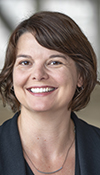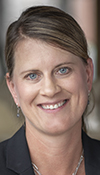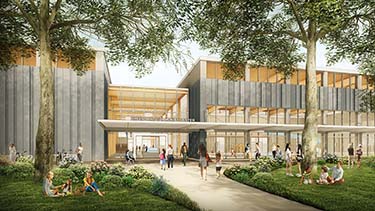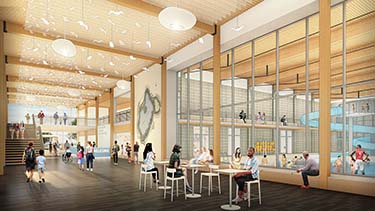|
Subscribe / Renew |
|
|
Contact Us |
|
| ► Subscribe to our Free Weekly Newsletter | |
| home | Welcome, sign in or click here to subscribe. | login |
Construction
| |
 |
March 4, 2021
Green Lake Community Center aims for inclusivity
Miller Hull

Post
|

Baleiko
|
A conceptual design for the Green Lake Community Center was recently released by the Seattle Parks and Recreation department, highlighting the work of architecture firm Miller Hull, as the result of considerable community engagement and feedback.
Tasked to design a replacement of the existing center and pool in one of the busiest parks in Seattle and all of Washington state, Miller Hull spent extensive time considering what an inclusive community center of the future would look like, as well as picturing how it would be integrated into the notable Olmsted park.
The unveiled design supports research concerning the benefits of social infrastructure, with emphasis placed on addressing the needs of all community members, including those without home, indigenous, and underserved populations. In addition, Miller Hull worked closely in partnership with landscape architect, Berger Partnership, and an environmental historian, Jennifer Ott, to ensure building and landscape proposals were sensitive to the history of the park.
COMMUNITY PROCESS
In 2020, communications firm Stepherson and Associates was hired by Seattle Parks and Recreation to join the project team in facilitating three open houses to gather community feedback and encourage public engagement. To begin dialect and gain valuable input, community members were asked a series of questions surrounding site locations and programmatic elements. Feedback directly influenced material presented at following sessions and eventually led to the completed, collaborative design. In the final session, Miller Hull demonstrated their process of taking the best attributes from each building concept to create one holistic solution; a new building design to replace the existing center.
Due to COVID, open houses were held virtually, including a dedicated website directing visitors to community surveys and project information made available prior to them sitting in on the digital presentations and interactive Q&A’s. All three presentations were recorded for digital access anytime afterward.
With more than 11,000 visitors and 5,700 survey respondents over three open houses, elements of this virtual community engagement process may become the way of the future, as the methodology reached a far greater audience than a typical in-person open house that the Parks department have historically held. With an average 80- to 100-person audience count for in-person events, this virtual method was able to capture a magnitude of people visiting the websites and participating in surveys or presentations. In addition to an increase in participants, this multi-pronged approach allowed for a more inclusive process and gave people varying ways to participate.
While this virtual strategy required more time and preparation than a typical community meeting, teams across the board agreed that going forward, and post COVID, some of these new strategies would need to be incorporated after seeing the sheer number of people who were able to, and wanted to participate. Discussions have also been held about ways to make the virtual outreach more inclusive, such as adding closed captioning software to assist hearing challenged participants.
EQUITY
The Seattle Parks and Recreation’s mission for this project to serve the entire city began with outreach to initiate the pre-design phase around site selection and other project needs. This outreach was successful in reaching many new target audiences. By continuing these efforts into the design phases, Miller Hull will ensure development of a facility that serves critical needs for a large portion of the population.
The design has taken into consideration universal facilities for restrooms and locker rooms open to all genders, ages, and abilities, hygiene stations for free and accessible showers, and that a large portion of community center programming will be free and available to all, including a toddler play area, gym, and exercise and fitness rooms.
WATER & ENERGY
Due to the large energy and water needs typical of swimming pool facilities, there is great potential for reducing resource consumption and long-term operating costs for the building. Design plans include implementing super-efficient systems to reduce demands, and development of alternative sources to further reduce dependence on utility systems. Swimming Pools are proven energy hogs, which is a primary reason energy strategies are gaining a large chunk of the attention on this project.
The current goal is making the Community Center portion of the program function at net zero energy while also taking a big chunk out of the pool energy use. As a result, a series of technology boxes will be checked such as high-efficiency ground source heat pumps, a building envelope designed to reduce energy loss, insulated pools and floors with radiant heating, and more photovoltaic panels on the roof and canopies than the amount strictly required to meet its LEED Gold target.
Innovative solutions for water conservation and re-use include cleaning and filtering pool water with regenerative filtration systems, reusing rainwater and treated greywater for flushing, irrigation, and pool make-up, and techniques for fully treating stormwater making its way into Green Lake.
CLIMATE
Development of the center comes at a critical time in addressing the climate crisis and in supporting the City’s approach to carbon-neutral operations. The project will serve as an example for best practices in driving down carbon emissions resulting from energy and water use, as well as embodied carbon emissions resulting from building construction. The building will operate only using electricity, a first for an SPR swimming pool, in order to target low-carbon operation. The Miller Hull design team has also run analyses using Tally, and have begun implementing design decisions in order to reduce embodied carbon.
HEALTH
Outside of a sustainable focused design, the project has an overarching mission to promote community health by providing recreation opportunities, social meeting space, and other services. Implementing strategies that lead to more healthy buildings and environments is critical to this success. The design team has created models to study air quality, developed a method for eliminating the most important and easily avoided red list materials, and included natural ventilation in the concept design, which can be used to improve air quality and save energy when outdoor conditions are beneficial.
LOOKING AHEAD
The construction for this project is not funded, and the design will likely be reconsidered and scaled to meet the fiscal realities of Seattle Parks and Recreation capital budget that has been greatly impacted by the pandemic.
Ruth Baleiko, a design partner at Miller Hull, creates spaces that bring people together to share intellectual and cultural capital in new, unexpected ways. Maaike Post, an associate at Miller Hull, gravitates toward public work and the chance to design projects available to all, including libraries and other community-centered projects.
Other Stories:
- How to keep the creative spark in a virtual world
- The role of ventilation and healthy air
- It’s the end of the grocery store (as we know it)
- Are American shopping malls boxed-in?
- Influencing human scale, creating a sense of place
- Here are the 3 principles of renovation
- The future of resilient commercial real estate
- Not all feasibility studies are created equal
- What if you can’t dig your way out of a brownfield cleanup?
- How A/E firms can increase proposal success in 2021
- Workplace wellness through technology
- 4 Living Buildings: collaborative, courageous, open-minded learning
- Foundations for healthy and sustainable urban places
- Parking garages: rethinking your front door
- A changed workforce and the implications for workplaces and cities




